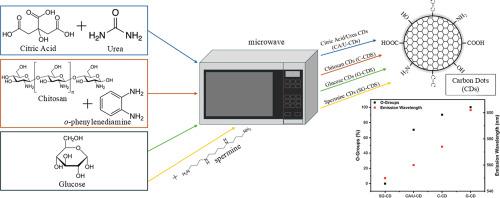Precursor effects on surface functionalization, photoluminescence, and cytotoxicity of carbon dots synthesized via microwave-assisted methods
IF 3.9
Q2 MATERIALS SCIENCE, MULTIDISCIPLINARY
引用次数: 0
Abstract
Carbon dots (CDs) produced by microwave-assisted methods have been extensively used in many applications such as theranostics. The microstructures and properties of CDs are highly associated with their precursors. However, few studies have reported on the effects of precursors on functional group-associated properties of CDs. Herein, different precursors were used to produce CDs with a microwave-assisted method, namely CDs made of (1) citric acid/urea (CA/U-CDs), (2) chitosan (C![]() CDs), (3) glucose (G-CDs), and (4) spermine/glucose (SG-CDs). CDs are all negatively charged except SG-CDs which show some positive charges. The photoluminescence of the CDs was measured at excitation of 480 nm, and Fourier Transform Infrared (FTIR) spectroscopy was employed to analyze the relative proportion of functional groups on CD surfaces, with results further confirmed by X-ray photoelectron spectroscopy (XPS) analysis. The more oxygen-containing groups compared to nitrogen-containing groups CDs have, the longer the emission wavelength (λem). In addition, the cytotoxicity of different CDs was investigated on NIH/3T3 mouse fibroblast cells. In particular, C
CDs), (3) glucose (G-CDs), and (4) spermine/glucose (SG-CDs). CDs are all negatively charged except SG-CDs which show some positive charges. The photoluminescence of the CDs was measured at excitation of 480 nm, and Fourier Transform Infrared (FTIR) spectroscopy was employed to analyze the relative proportion of functional groups on CD surfaces, with results further confirmed by X-ray photoelectron spectroscopy (XPS) analysis. The more oxygen-containing groups compared to nitrogen-containing groups CDs have, the longer the emission wavelength (λem). In addition, the cytotoxicity of different CDs was investigated on NIH/3T3 mouse fibroblast cells. In particular, C![]() CDs improved cell growth with cell viability >100% after 24 h but decreased viability at longer incubations, likely due to increased uptake and lysosomal stress. In contrast, G-CDs exhibited stable biocompatibility over 72 h. This study demonstrates the effect of functional groups on CDs made with different precursors on their surface charge, emission, and cytotoxicity, which may provide guidance to the design and development of CDs with tunable photoluminescence and biocompatible properties.
CDs improved cell growth with cell viability >100% after 24 h but decreased viability at longer incubations, likely due to increased uptake and lysosomal stress. In contrast, G-CDs exhibited stable biocompatibility over 72 h. This study demonstrates the effect of functional groups on CDs made with different precursors on their surface charge, emission, and cytotoxicity, which may provide guidance to the design and development of CDs with tunable photoluminescence and biocompatible properties.

微波辅助法合成碳点的表面功能化、光致发光和细胞毒性前体效应
微波辅助制备的碳点在治疗学等领域得到了广泛的应用。CDs的微观结构和性能与其前体密切相关。然而,很少有研究报道前体对CDs官能团相关性质的影响。本文采用微波辅助法制备了不同前体CDs,分别为(1)柠檬酸/尿素(CA/U-CDs)、(2)壳聚糖(CCDs)、(3)葡萄糖(G-CDs)和(4)精胺/葡萄糖(SG-CDs)。cd都带负电荷,除了sg - cd带一些正电荷。利用傅里叶变换红外光谱(FTIR)分析了CD表面官能团的相对比例,并通过x射线光电子能谱(XPS)分析进一步证实了这一结果。含氧基团越多,cd的发射波长(λem)越长。此外,还研究了不同CDs对NIH/3T3小鼠成纤维细胞的细胞毒性。特别是,CCDs在24小时后提高了细胞生长,使细胞活力达到100%,但在更长的孵育时间内,细胞活力下降,可能是由于摄取增加和溶酶体应激。而G-CDs在72 h内表现出稳定的生物相容性。本研究证实了不同前驱体制备的CDs的官能团对其表面电荷、发射和细胞毒性的影响,为设计和开发具有可调光致发光和生物相容性的CDs提供指导。
本文章由计算机程序翻译,如有差异,请以英文原文为准。
求助全文
约1分钟内获得全文
求助全文
来源期刊

Carbon Trends
Materials Science-Materials Science (miscellaneous)
CiteScore
4.60
自引率
0.00%
发文量
88
审稿时长
77 days
 求助内容:
求助内容: 应助结果提醒方式:
应助结果提醒方式:


